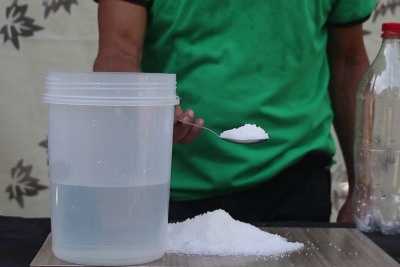There’s an easy and quick way to prepare liquid fertilizer. All it takes is to dissolve urea (46-0-0) in water.
This dilute solution can be immediately used for soil drench and spray application to supplement nitrogen to plants in need of the nutrient or to ensure its availability.

1% urea solution can be prepared just before application
The basic procedure that we follow is based on the long-established fact that 1% urea solution can be sprayed or used to water many plants including the leafy vegetable pechay (Brassica sp.).
As for maintenance fertilizer for potted seedlings in the nursery, we do the watering once a week to once every two weeks.
But first, the theoretical basis.
Here’s How to Prepare a 1% w/v Urea Liquid Fertilizer
Materials:
- Urea granules or 46-0-0
- Water
- Weighing scale
- Container to hold water such as a plastic pail or basin
- 1-li water dispenser
- Water-resistant marker
Procedure:
1. Decide on the volume of liquid fertilizer to prepare, for example, 10 liters.
2. Convert the volume of liquid fertilizer to unit of weight (from ml to gram) by using the following 1:1 volume-to-weight equivalent of water at normal atmospheric pressure: 1 ml = 1 cc = 1 g or 1 li = 1 kg.
Then calculate the weight of urea (46-0-0) granules to dissolve with the following formula:
Wu = Cu x Wf
where:
Wu = weight of urea to be dissolved (in gram)
Cu = desired concentration of urea in the liquid fertilizer (in decimal, i.e., 1% = 1/100 = 0.01)
Wf = weight of liquid fertilizer to be prepared (in gram, i.e., 10 li = 10 li x 1,000 ml/li = 10,000 ml = 10,000 g).
Solution:
Formula: Wu = Cu x Wf
Wu = 0.01 x 10,000 g= 100 g
Note: The unit of measurement for the weight of liquid fertilizer to be prepared (Wf) may be in kilogram (kg).
If so, Wu will also be in kg.
To convert kg to gram (g), multiply by 1000 since 1 kg = 1,000 g. Therefore, 0.1 kg is equivalent to 100 g. That is, 0.1 kg x 1,000 g/kg = 100 g.
Conversely, gram can be converted to kilogram by dividing it by 1,000. Therefore, 100 g is equivalent to 0.1 kg. That is, 100 g ÷ 1000 g/kg = 0.1 kg.
3. Pour 10 liters of water into a container (e.g. plastic basin or pail).
Allow the water to settle and mark the 10-li level. Then remove water in excess of 100 ml from the container.
4. Weigh 100 grams of urea and add to the water in the container. Stir by hand or any stirrer until completely dissolved.
5. Allow the liquid solution to settle then slowly add more water up to the 10-li mark.
Note:
The above steps provide for the production of a 1% w/v urea liquid fertilizer.
It means that the fertilizer solution has a 1% concentration of urea, w/v basis. “w/v” means “weight over volume.” That is,
Urea Concentration = (Wu ÷ Vf) x 100 = (100 g/10,000 ml) x 100 = 1%,
where 100 g is the weight of urea and 10,000 ml is the total volume of the liquid fertilizer.
The multiplier “100” without any unit of measurement is a constant in converting fraction (w/v) to percentage (%).
As an alternative, the weighed urea (100 g) may be dissolved in water that is poured into a container placed on a weighing scale.
After the urea is completely dissolved, water is added until the weight of the solution reaches the 10-kg mark.
This will produce 1% w/w urea solution.
Precision in producing a 1% w/w concentration of the liquid fertilizer will depend largely on the accuracy of the weighing scale.
The Volume of Liquid Water Used as Solvent
The amount of water that was used to dissolve 100 grams of urea to produce 10 liters of liquid fertilizer with 1% concentration of the solute can be derived.
Use the following formula:
Vw = Vf – Vu
where:
Vw = volume of water used as solvent (ml)
Vf = volume of liquid fertilizer prepared (ml)
Vu = volume of urea dissolved in water (ml, i.e., 100 ml = 100 g).
Solution:
Vw = 10,000 ml – 100 ml = 9,900 ml
Click here to read more about the density of water
Practical Application
For landscape and house plants, as well as for potted seedlings in the nursery, there is no necessity for technical accuracy.
For convenience, it is sufficient to dissolve 1 level tablespoon of urea granules in 1 liter of water or multiples thereof.
This is based on the approximation that 1 tablespoon of water is equal to 10 ml or 10 grams.
As a measuring tool for the solvent in excess of 1 liter, water is poured from a 1-liter bottle into a dipper and the top level is marked.
One (1) heaping tablespoon of urea dissolved in water dispensed from a 1.5-liter softdrink bottle will have approximately the same dilution rate.
The above procedures allow the production of liquid fertilizer in small quantities without using a weighing scale.
Otherwise, if the amount of urea to be dissolved is so small, for example, 10 grams, it will be necessary to produce a digital balance or one that is capable of detecting such weight.

Hi Ben. Thanks for this info. What would be the recommended spray area of a lawn with either 1tbs x litre water. What would be consideration to use 2tbs x 1litre water. Regards.
Being a practical farmer it has been very helpful. Please could you do same kind of calculation to produce 1% solution of 20 20 30 Haifa bonus NPK that can be used to water plants directly since the quantities are not the same..